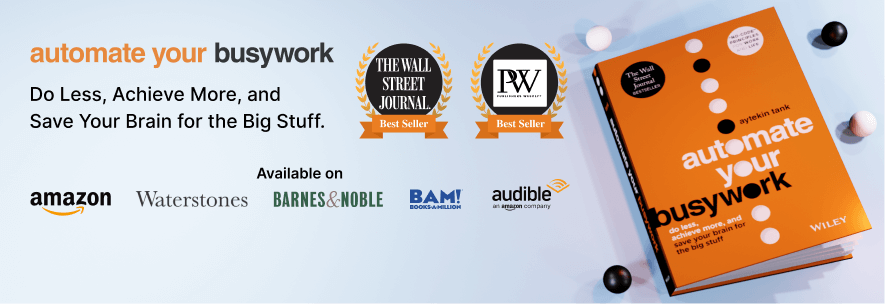Not all million-dollar ideas are obvious.
Sometimes, what begins as a failed idea becomes a groundbreaking innovation.
Consider the Post-it®. While trying to create a stronger, more durable adhesive, Dr. Spencer Silver, a 3M scientist, discovered an adhesive that stuck lightly to surfaces.
The “removability” rendered it a failure — yet it was also revolutionary. But it took years before this innovation was recognized, as Silver searched to find a use for his creation.
“I came to be known as Mr. Persistent because I wouldn’t give up,” Silver explains on the company’s website.
He eventually partnered with a fellow 3M scientist to create the small sticky notes we all know and love. The average professional now receives 11 messages on Post-its each day and they’re sold in over 100 countries worldwide.
Recently, as I scribbled a quick Post-it reminder for myself, I started thinking about what we can learn from Silver’s story: about innovation, experimentation, and the necessity of occasional failures.
It also made me wonder: how often do we overlook great ideas? Probably more than we realize. For example, Kodak invented the first digital camera but decided not to pursue it. Sony developed its own prototype and captured the future of digital photography.
In order to foster innovation and ensure that great ideas, particularly those right under our noses, don’t go unrecognized, we can start by making small but impactful changes to our company culture and idea pipelines.
How good ideas get stopped in their tracks
We all want our companies to be considered “innovative.” But talking the talk isn’t the same as walking the walk. Several factors often prevent organizations from living up to their creative aspirations.
Writes Northwestern professor Brian Uzzi:
“Innovation requires allocation and deployment of organizational resources, often significant amounts, without definitive proof of future returns. This ambiguity allows politics to enter into the choice process…”
And politics tend to favor the status quo, rather than disruptive innovations, especially those that require performance validation.
Too often, companies emphasize demonstrable impact and significant results to the detriment of innovation. They want to see immediate profitability and are uncomfortable exploring the unlikely or the unknown.
Maybe this standard works for multinational companies with massive R&D budgets. For example, HP, a company worth $100 billion (as estimated in 2009), once determined that projects had to generate at least $1 billion in impact in to receive a green light.
Prith Banerjee, former head of HP Labs, explained that projects must “advance the state of the art by at least an order of magnitude in whatever they do,” and “present a significant commercial impact for HP.”
For most startups, this type of threshold is too limiting, and stifles creativity.
When companies lack a clear system for employees to submit their ideas for review, that can present another roadblock to innovation.
A study from Accenture found that 72 percent of companies allow innovations to die because there’s no formalized process to review and evaluate suggested ideas.
And, as I’ll explain, a review process doesn’t even have to be, well, innovative. A simple system can spur employee creativity and generate your company’s next million dollar idea.
Dismantling the roadblocks to innovation
1. Nix (or effectively navigate) the politics
When resources are limited, and people have differing interests, some politics are inevitable. People will work to garner support for their interests and lobby those with the most clout.
To help prevent politics from blocking innovation, we can equip our teams with strategies and tools to advocate for their ideas. For example, encourage employees to focus on solving an existing problem and to demonstrate how their innovation fits with the organization’s agenda. This approach can help to counter the inevitable resistance to a new use of company resources.
“If you know what people might object to then you can position your innovation strategically: as something new and creative, but not as a resource-depleting departure from the organization’s existing agenda,” says Uzzi. “That is, you can make the idea ‘just fresh enough.’”
Which brings up another key point — not every idea has to reinvent the wheel. Tweaks can be an important type of innovation, not to mention, easier to digest.
Some of the greatest inventors were in fact tweakers (as in makers of fine adjustments, versus the slang sense of the word).
Take Steve Jobs: his biographer Walter Isaacson doesn’t paint the late Apple CEO as a large-scale visionary, but rather, a tweaker. Jobs took things that others had created, such as the smartphone and the tablet, and perfected them. That was Jobs’ real genius.
Changing the structure that ideas move through can also reduce politicking. Instead of the usual hierarchy, spread the approval process across the organization.
I recently read about a company called Rite Solutions that developed a fantastic way to generate new ideas.
Rather than submitting proposals for review behind closed doors, employees use the company’s “idea market,” where anyone can post an idea, which is then listed as “stock” on the market.
“Every employee is also given $10,000 in virtual currency to ‘invest’ in ideas, explains Harvard Business Review contributor David Burkus. “In addition to the investment, employees also volunteer to work on project ideas they support. If an idea gathers enough support, the project is approved and everyone who supported it is given a share of the profits from the project.”
Not only is Rite Solutions’ review process open and democratic, but employees also have incentives to collaborate and rally behind each other’s ideas.
Even if the ultimate deciding power rests in the hands of few, the selection process should be transparent. All contributors should receive objective explanations for why their idea was or wasn’t greenlit.
2. Establish a clear system
On a more fundamental level, it’s important that all employees know the idea submission system, which can be as elaborate as an “idea market” or as simple as a digital suggestion box.
But, you might wonder, how effective is a suggestion box?
Very effective. Just ask Jeff Bezos.
Or better yet, ask Charlie Ward, the Amazon engineer who used the company’s virtual suggestion box to submit his idea for free shipping, which eventually formed the basis of Amazon Prime.
Bezos was reportedly “immediately enchanted by the idea.” As were customers.
Today, Citigroup predicts that Prime subscriptions will reach 275 million by 2029. That’s up from 101 million at the end of 2017, as roughly 80 percent of U.S. households adopt the service.
So, don’t underestimate the power of the suggestion box.
At Jotform, our weekly Demo Days give employees a forum to explore their ideas. I love this system, because it routinely encourages curiosity and out-of-the-box thinking. It also opens a dialogue and lets employees evaluate each other’s projects in a safe, open environment.
Whichever system you choose, make sure it’s easily and regularly accessible to employees.
3. Welcome the possibility of failure
Fear of failure kills innovation. That’s why the most forward-thinking companies embrace risk-taking and the possibility of failure.
It explains why Apple released MobileMe, Google rolled out Google Glass, and Amazon once offered a Fire Phone — all ultimately failed products that show each company’s willingness to take a gamble.
Though none of these innovations took off, I’m sure that each provided important teachable moments.
Google, for example, has said that any new Glass generation won’t be released until it’s ready for public sale. You may remember how much hype surrounded the early iterations of Google Glass — and how much criticism they incited, because no one actually wanted to wear them.
I’ll be the first to admit, engineers and programmers are rarely style icons. And Google designers, no doubt, gained important insights about creating consumer-friendly hardware.
Tolerating failure, however, does not mean tolerating incompetence.
As Harvard Business School professor Gary P. Pisano explains:
“Exploring risky ideas that ultimately fail is fine, but mediocre technical skills, sloppy thinking, bad work habits, and poor management are not.”
Still, that doesn’t mean companies can’t poke fun at failures when they do happen — to add a little levity to their sometimes high-stress work environments, and to give employees a sense of psychological safety.
Intuit, for example, hosts company-wide “failure awards,” to recognize teams whose ideas failed but provided valuable lessons in the process.
Not only is the company creating a learning opportunity, they’re also encouraging innovation by removing the element of fear.
The more ideas, the better
So many factors determine whether or not an idea will eventually take off.
Given slightly different circumstances, perhaps we’d all be wearing Google glasses and scribbling notes on Press ‘n Peels (the original name for Post-its, which met with mixed reviews).
Because all ideas, even the failed ones, hold valuable lessons, I think it’s important to foster as much idea generation as possible — both the revolutionary and the small but powerful tweaks.














Send Comment: